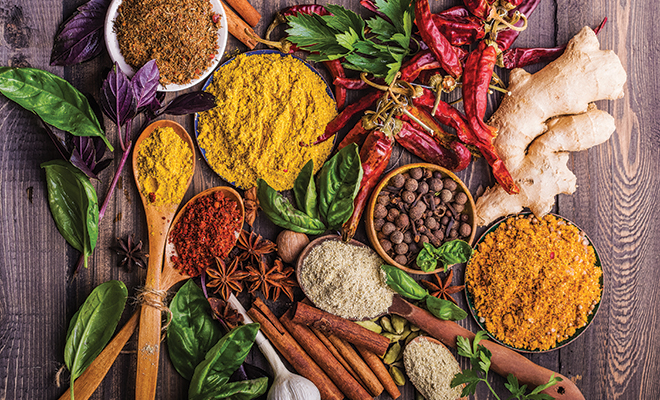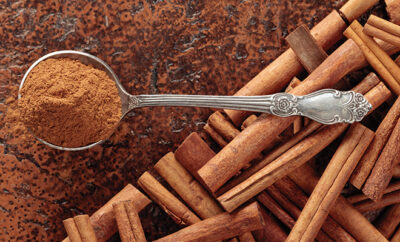
Be a Saucy, Spicy Cook
Home cooks sometimes hit a wall when preparing a meal. Sometimes we just have to hit the sauce.No, not the liquor cabinet; some dishes just cry out for an extra something. We need a secret sauce, if you will–or dressing, or puree, or dip or seasoning.
Why? Because tasty sauces and condiments can elevate an otherwise not-so-special dish to a fancy meal. Many people resist the idea of prepping sauces because it seems too complicated to whip up a sauce at the last minute. But if you think about it, we’re trained to expect these little extras from childhood. Imagine serving a kid French fries without ketchup, chicken tenders without honey mustard, mashed potatoes without gravy, or broccoli and cauliflower without melted cheese. Desserts are always more special if they involve sauces of chocolate, caramel or berries. In the same way, meals are enhanced with the addition of sauces, such as béarnaise sauce with steaks, hollandaise sauce with steamed asparagus, and béchamel sauce with pasta, to name a few.
If you’re not in the habit of experimenting with these culinary extras, let’s take a quick look at how they can take your meals from everyday to extra-special fare.
There are a few basic French sauces that are worth knowing: Béchamel, velouté and hollandaise. These basic or “mother” sauces form the framework for many different “small” sauces, depending on what is added to them. First, we’ll look at sauces that involve a roux, which is a mixture of flour and butter, cooked and stirred long enough that the taste of raw flour is gone. How long? That depends on whether you want a white sauce or a brown sauce.
Béchamel is a white sauce used in casseroles, such as moussaka, and pasta dishes, among others. It’s basically warm milk mixed into a roux of flour and butter, often flavored with onions and spices such as nutmeg, and simmered until thick and creamy. If you add cheeses, such as gruyère and parmesan, you’ve got Mornay sauce, used for vegetable, egg and fish dishes. Or add prepared mustard to create mustard sauce for eggs or chicken. In place of butter, use shrimp or crayfish butter to make Nantua sauce for fish and seafood.
Velouté, the French word for velvet, is similar to Béchamel; it also requires a roux, but substitutes a white stock made of chicken, veal or fish for the milk. Add white wine, hot paprika and onions for a Hungarian sauce over chicken, or tarragon, chives and parsley for an herbed fish sauce.
Hollandaise stands out as it requires clarified butter and egg yolks, with a dash of cayenne pepper. Clarified butter is added to warm egg yolks to emulsify the sauce; the water and milk solids in regular butter can “break” the sauce, making it clump. Add tarragon, shallots and black pepper to make Béarnaise sauce, which is terrific dolloped into little scooped-out tomatoes and served alongside sliced grilled steak.
A more rare sauce with English origins is superb with wild game, ham and goose, Cumberland sauce. It’s made from simmered zest of lemon and orange, with red currant jelly, port, dry mustard and ginger added to it. Unlike French sauces, this is meant to be served on the thin side, rather than thickened.
Let’s move away from sauces and look at ways to use pureed vegetables and fruit. Most of us hate the fact that we throw away food every week; we paid for it at the grocery store only to send it to a landfill. The next time you’re faced with a few leftover veggies, rather than toss them out, consider blending them to stash in the freezer. Why take the time to do this? The next time you make a soup or a stew, grab some pureed carrots, onions, beans or potatoes and toss them in the soup for extra nutrition, flavor and thickening. If you have an avocado going to waste, puree it with a tablespoon of lemon or lime juice to use later in guacamole or as a sandwich spread. Berries that are going to waste can be pureed, then thawed and mixed with a bit of jelly or jam to top off a serving of fruit or ice cream.
Last but not least, there are countless herbs and spices that enhance vegetables, grilled meats and dips such as hummus. One example is North African harissa, a blend of chilies, garlic, caraway, coriander, cumin, mint and lemon. Indian garam masala also uses chilies and coriander, adding cumin, cardamom, cloves, nutmeg and cinnamon.
Are you in a culinary rut? If so, pull out your favorite cookbook and look in the index for “Sauces.” What you learn, or try for the first time, may become a favorite recipe that you use time and again. ■
Sources: culinaryarts.about.com, deliaonline.com and Lucky Peach magazine.







